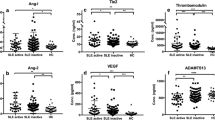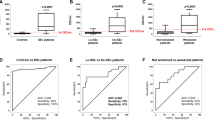Abstract
Henoch–Schönlein purpura (HSP) is a commonest systemic vasculitis (SV) in childhood characterized by an inflammatory reaction directed at vessels. Endothelial damage and perivascular leukocyte infiltrates are vital in the development of HSP. Vascular endothelial (VE)-cadherin is an endothelial cell-specific adhesion molecule, which plays critical roles in angiogenesis and endothelial integrity. Herein, we investigated the serum levels of soluble VE-cadherin (sVE-cadherin) in patients with HSP and other forms of SV. The serum levels of sVE-cadherin in 30 patients with HSP, together with patients with urticarial vasculitis, allergic vasculitis, Behcet disease, psoriasis vulgaris (PV) and atopic dermatitis (AD) and 26 health controls were measured by enzyme-linked immunosorbent assay. Serum levels of sVE-cadherin were significantly increased in patients with HSP in acute stage and patients with other forms of SV but not in patients with PV or AD. Moreover, Serum sVE-cadherin levels in HSP patients were correlated with the severity of this disease and serum concentrations of IgA anticardiolipin antibodies and vascular endothelial growth factor. Taken together, we show firstly that serum sVE-cadherin is abnormally increased in HSP patients. Increased serum levels of sVE-cadherin might be a novel biomarker for evaluating the severity of HSP and useful for identifying the presence of SV in inflammatory skin conditions.


Similar content being viewed by others
References
Linskey KR, Kroshinsky D, Mihm MC Jr, Hoang MP (2012) Immunoglobulin-A associated small-vessel vasculitis: a 10 year experience at the Massachusetts General Hospital. J Am Acad Dermatol 66:813–822
Del Vecchio GC, Penza R, Altomare M, Piacente L, Aceto G, Lassandro G et al (2008) Cytokine pattern and endothelium damage markers in Henoch–Schönlein purpura. Immunopharmacol Immunotoxicol 30:623–629
Chen T, Jia RZ, Guo ZP, Cao N, Li MM, Jiao XY (2013) Elevated serum interleukin-33 levels in patients with Henoch–Schönlein purpura. Arch Dermatol Res 305:173–177
Chen T, Guo ZP, Li MM, Li JY, Jiao XY, Zhang YH et al (2011) Tumour necrosis factor-like weak inducer of apoptosis (TWEAK), an important mediator of endothelial inflammation, is associated with the pathogenesis of Henoch–Schönlein purpura. Clin Exp Immunol 166:64–71
Chen T, Guo ZP, Jiao XY, Jia RZ, Zhang YH, Li JY et al (2011) CCL5, CXCL16, and CX3CL1 are associated with Henoch–Schönlein purpura. Arch Dermatol Res 303:715–725
Chen T, Guo ZP, Zhang YH, Gao Y, Liu HJ, Li JY (2011) Elevated serum heme oxygenase-1 and insulin-like growth factor-1 levels in patients with Henoch–Schönlein purpura. Rheumatol Int 31:321–326
Petreaca ML, Yao M, Liu Y, Defea K, Martins-Green M (2007) Transactivation of vascular endothelial growth factor receptor-2 by interleukin-8 (IL-8/CXCL8) is required for IL-8/CXCL8-induced endothelial permeability. Mol Biol Cell 18:5014–5023
Alexander JS, Alexander BC, Eppihimer LA, Goodyear N, Haque R, Davis CP (2000) Inflammatory mediators induce sequestration of VE-cadherin in cultured human endothelial cells. Inflammation 24:99–113
Sidibé A, Mannic T, Arboleas M, Subileau M, Gulino-Debrac D, Bouillet L et al (2012) Soluble VE-cadherin in rheumatoid arthritis patients correlates with disease activity: evidence for tumor necrosis factor α-induced VE-cadherin cleavage. Arthritis Rheum 64:77–87
Herren B, Levkau B, Raines EW, Ross R (1998) Cleavage of beta-catenin and plakoglobin and shedding of VE-cadherin during endothelial apoptosis: evidence for a role for caspases and metalloproteinases. Mol Biol Cell 9:1589–1601
Schulz B, Pruessmeyer J, Maretzky T, Ludwig A, Blobel CP, Saftig P et al (2008) ADAM10 regulates endothelial permeability and T-cell transmigration by proteolysis of vascular endothelial cadherin. Circ Res 102:1192–1201
Soeki T, Tamura Y, Shinohara H, Sakabe K, Onose Y, Fukuda N (2004) Elevated concentration of soluble vascular endothelial cadherin is associated with coronary atherosclerosis. Circ J 68:1–5
Abu El-Asrar AM, Nawaz MI, Kangave D, Abouammoh M, Mohammad G (2012) High-mobility group box-1 and endothelial cell angiogenic markers in the vitreous from patients with proliferative diabetic retinopathy. Mediat Inflamm 2012:697489
Habibagahi Z, Habibagahi M, Heidari M (2010) Raised concentration of soluble form of vascular endothelial cadherin and IL-23 in sera of patients with Behcet’s disease. Mod Rheumatol 20:154–159
Kawakami T, Watabe H, Mizoguchi M, Soma Y (2006) Elevated serum IgA anticardiolipin antibody levels in adult Henoch–Schönlein purpura. Br J Dermatol 155:983–987
Topaloglu R, Sungur A, Baskin E, Besbas N, Saatci U, Bakkaloglu A (2001) Vascular endothelial growth factor in Henoch–Schönlein purpura. J Rheumatol 28:2269–2273
Mills JA, Michel BA, Bloch DA, Calabrese LH, Hunder GG, Arend WP et al (1990) The American College of Rheumatology 1990 criteria for the classification of Henoch–Schönlein purpura. Arthritis Rheum 33:1114–1121
Yang YH, Wang SJ, Chuang YH, Lin YT, Chiang BL (2002) The level of IgA antibodies to human umbilical vein endothelial cells can be enhanced by TNF-alpha treatment in children with Henoch–Schönlein purpura. Clin Exp Immunol 130:352–357
Kawakami T, Yamazaki M, Mizoguchi M, Soma Y (2008) High titer of serum antiphospholipid antibody levels in adult Henoch–Schönlein purpura and cutaneous leukocytoclastic angiitis. Arthritis Rheum 59:561–567
Villasante A, Pacheco A, Ruiz A, Pellicer A, Garcia-Velasco JA (2007) Vascular endothelial cadherin regulates vascular permeability: implications for ovarian hyperstimulation syndrome. J Clin Endocrinol Metab 92:314–321
Acknowledgments
The study was supported, in part, by Natural Science Foundation of China (81101198 and 81271752).
Conflict of interest
None.
Author information
Authors and Affiliations
Corresponding author
Rights and permissions
About this article
Cite this article
Chen, T., Guo, Zp., Cao, N. et al. Increased serum levels of soluble vascular endothelial-cadherin in patients with systemic vasculitis. Rheumatol Int 34, 1139–1143 (2014). https://doi.org/10.1007/s00296-014-2949-7
Received:
Accepted:
Published:
Issue Date:
DOI: https://doi.org/10.1007/s00296-014-2949-7




